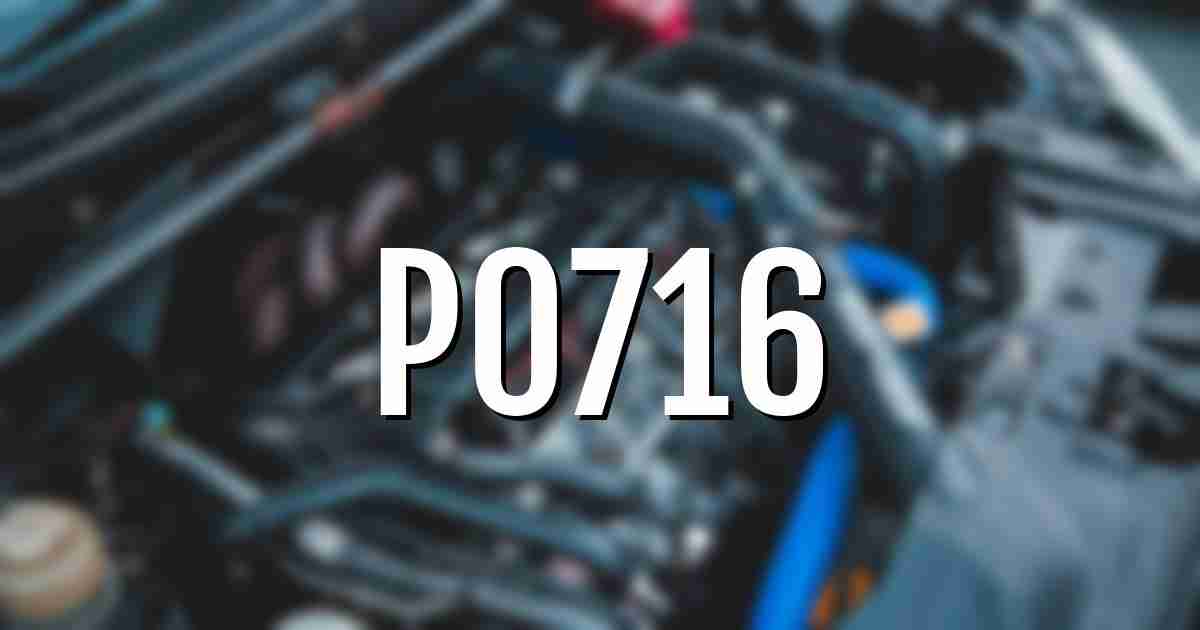The automobile fault code P0716 indicates a problem with the Transmission Speed Sensor. The symptoms of this issue may include erratic shifting, harsh shifting, or the transmission not shifting at all. The most common cause of this fault code is a faulty Transmission Speed Sensor, but it can also be caused by an open or shorted sensor harness or a poor electrical connection.
To fix this issue, you should visually inspect the wiring harness and connectors for any damage. Look for broken, bent, pushed out, or corroded pins on the connectors.
The repair time for this issue is estimated to be around 1.0 hour. It is important to address this problem promptly to avoid further damage to the transmission.
| Repair Importance Level | 10.0 (Out of 10) |
| Estimated Repair Time | Approximately 1.0 hour |
| Repair Difficulty Level | 10.0 (Out of 10) |
Decode The Symptoms Of Code P0716: Unveiling The Automotive Mystery
Experiencing shifting issues, erratic speedometer readings, and possible transmission overheating are common symptoms of the p0716 fault code.
- The symptoms of the automobile fault code P0716 include erratic or harsh shifting, delayed or no shifting, slipping transmission, incorrect gear ratio, illuminated check engine light, and decreased fuel efficiency.
Unraveling The Mystery: What Causes Fault Code P0716?
The fault code p0716 can be caused by a faulty transmission speed sensor, an open or shorted sensor harness, or a poor electrical connection in the sensor circuit.
- The fault code P0716 can be caused by the following: a faulty transmission speed sensor, an open or shorted transmission speed sensor harness, and a poor electrical connection in the transmission speed sensor circuit.
Do you know you can clear most fault codes—but some could mean serious danger? Don’t take chances with your safety or your family’s safety. This budget-friendly car scanner makes it easy to clear fault codes in seconds while showing you exactly what’s wrong. Plug it in, connect to your Android or iOS phone, and instantly check live data. You’ll know if it’s a minor issue you can clear or something serious that needs attention—so you can drive safely and stress-free. (Today’s Deal)
Fixing Code P0716: Your Step-By-Step Solution For Transmission Issues
To fix the p0716 fault code, start by visually inspecting the wiring harness, connectors, and components for any damage or corrosion.
- To fix the automobile fault code p0716, start by checking the possible causes mentioned above.
- Then, visually inspect the wiring harness and connectors related to the issue.
- Look for any damaged components and check if there are any broken, bent, pushed out, or corroded pins in the connectors.
- This fix should take approximately 1.0 hour.
Cracking The Code: P0716 – Cost And Complexity Unveiled!
The factors influencing the diagnosis and fixing cost of the automobile fault code p0716 are the estimated repair time of 1.0 hour and the average hourly rate charged by auto repair shops, which ranges between $75 and $150.
That fault code is a turning point. If repair costs are climbing and your current loan feels like it’s holding you back, this is the time to plan ahead. The free Car Loan Payment Tracker helps you see how quickly you can pay off what’s left—and start preparing, with confidence, for your dream car.
Decode P0716: Unveiling Symptoms And Solutions
When you see the Engine Light ON or the Service Engine Soon Warning Light, it could be due to the fault code P0716. This code indicates a possible issue with shifting in your vehicle.
It means that there may be a problem with the input speed sensor circuit in the transmission.
This sensor is responsible for monitoring the speed of the input shaft, which helps the transmission determine when and how to shift gears.
If this sensor is malfunctioning or sending incorrect signals, it can lead to shifting problems and potentially affect the overall performance of your vehicle.
It is important to have this issue diagnosed and repaired by a qualified mechanic to ensure smooth and efficient shifting in your vehicle.
FAQ
If you’re seeing fault code P0716 in your automobile, it could be due to a few possible causes. One of the main culprits could be a faulty Transmission Speed Sensor. Another possibility is that the Transmission Speed Sensor harness is open or shorted. Additionally, a poor electrical connection in the Transmission Speed Sensor circuit could also be to blame. To fix this issue, start by visually inspecting the wiring harness and connectors. Look out for any damaged components and check for broken, bent, pushed out, or corroded connector pins.
To visually inspect the wiring harness and connectors related to the transmission speed sensor, start by checking for any damaged components and looking for broken, bent, pushed out, or corroded connector pins. This can help identify any issues with the transmission speed sensor harness, such as an open or shorted circuit or a poor electrical connection. By conducting a thorough visual inspection, you can pinpoint the cause of the problem and proceed with the necessary fix.
When checking the connector’s pins for fault code P0716, it is important to visually inspect the related wiring harness and connectors. Look for any damaged components and pay close attention to the connector’s pins. Check for any signs of broken, bent, pushed out, or corroded pins. These issues can cause a poor electrical connection and contribute to the fault code. By identifying and addressing these problems, you can effectively fix the P0716 fault code.

Wrap Up
If you’re experiencing issues with your transmission, such as erratic shifting or a lack of power, the P0716 fault code may be the culprit. This code is typically caused by a faulty transmission speed sensor or issues with the sensor’s wiring harness. To fix the problem, visually inspect the wiring harness and connectors for any damage or corrosion.
Look out for broken or bent pins as well.

